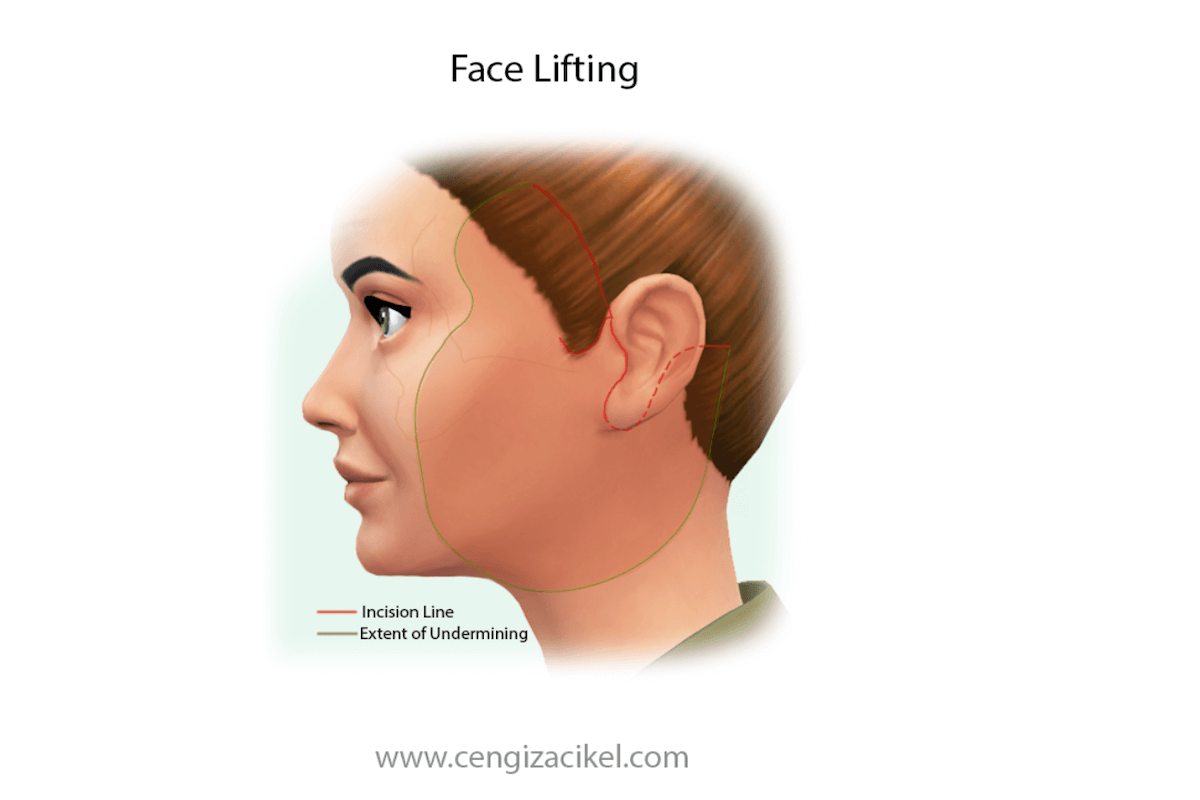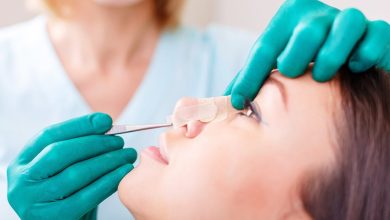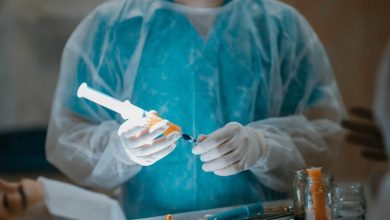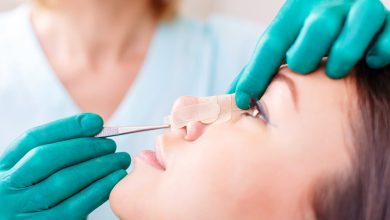Facelift Surgery
Facelift, also known as full facelift, meloplasty or rhytidectomy, is a surgical procedure intended to eliminate sagging in the cheek and jowl regions and to give the face a younger appearance. This procedure performed under general anesthesia by Plastic, Reconstructive and Aesthetic Surgery specialists can also be performed in conjunction with other aesthetic procedures to eliminate the signs of aging in other parts of the face.
This surgical procedure treats sagging and loose skin in some parts of the face such as the cheekbones, cheeks and corners of the chin, and in the neck area. Full facelift is not a standard surgical procedure. A wide variety of surgical techniques are used under the name of facelift. Facelift can be performed alone but can also be combined with other aesthetic procedures intend to treat problems in other parts of the face, such as the under-eye bags.
How Is Facelift Performed?
- It is usually performed under general anesthesia in operating room conditions, and takes 4 to 6 hours.
- The skin incision starts from the scalp in the temple area, extends downwards in front of the ear, continues under the earlobe, follows the back of the ear, and bends into the scalp.
- The skin of the cheek and neck is lifted, and the loose and sagging layer of the face called SMAS is pulled sideways and upwards and fixed with sutures to the places where it should be.
- If additional incision and lifting are required in the jowl area, it is performed as well.
- The excess skin of the face is removed.
- Drains are placed to remove the accumulated fluid.
- The incisions on the skin are closed with sutures.
- If needed, combined procedures such as blepharoplasty and fat injection are performed, and the surgery is terminated.
Factors That Cause Aging of the Face
Not everyone’s face ages within the same time or in the same way. There are many factors affecting the speed and severity of aging. Some of these factors are out of our control and we have nothing to do in this regard; but some of them are manageable and managing them can delay the signs of aging.
- Advanced age
- Gravity
- Genetic and structural factors. Each individual has a different skin structure, soft tissue elasticity and resistance to aging.
- Excessive sun exposure
- Smoking (cigarettes and other tobacco products)
- Alcohol and substance use
- Irregular and stressful lifestyle
- Irregular sleeping habit
- Inadequate water consumption
- Excessive weight gain and loss
- Unsuitable cosmetics
- Menopause and bone loss
- Underlying diseases
Signs of Facial Aging
- The facial skin loses its softness and shine, becoming harder and dull. Fine wrinkles, spots, and roughness develop on the skin.
- Wrinkles in the facial expression areas, in the under-eye region, on the lips and around the corners of the mouth begin to deepen.
- The forehead expands and the eyebrows droop, causing the eyes to look tired and sad.
- Sags and folds develop in the upper eyelids.
- Bags and wrinkles develop in the lower eyelids.
- Collapses and fading occur in the under-eye region and on the cheekbones.
- The cheeks sag, and the sagging skin at both sides of the chin impairs the youthful appearance of the jaw line.
- The tip of the nose droops.
- The lips get thinner and sag. The upper lip covers the upper teeth like a curtain, while the lower teeth become visible.
- The corners of the mouth move downwards, causing a sad expression.
- The lower jaw tip becomes smaller, while the sagging skin on both sides becomes more noticeable.
- Laxity, sagging and wrinkles occur in skin of the jowl area and the neck.
- The laxity and sagging in the facial are accompanied by reduced volumes of the subcutaneous fat pads and bone structures.
Facial Rejuvenation Procedures
There are many surgical and non-surgical procedures intended to eliminate the signs of facial aging. Non-surgical procedures such as laser, radiofrequency, chemical peeling, IPL, microdermabrasion, PRP, Salmon DNA vaccine, fibroblast and vitamin mesotherapy, thread facelift, ready-made/temporary filler injection and surgical procedures such as forehead lift brow lift, blepharoplasty, fat injection, facelift, mini face lift, midface lift, neck lift can be performed alone or in conjunction with other procedures.
Before Face Lift Operation
In order to ensure a problem-free surgical process, it is necessary to start taking some precautions in the preparation process at least 15 days prior to the date of surgery. Especially in cases where the patient uses estrogen-like hormonal support pills due to menopause, such drugs should be discontinued 1 month before the surgery to reduce the risk of clot formation in the leg veins.
If the patient is on medications or nutritional supplements blood-thinning effects such as aspirin, green tea, vitamin E, these should be discontinued these at least 2 weeks before the date of surgery. On our webpage entitled before surgery, you can find a detailed list of the precautions to be taken before surgery.
In addition, additional measures should be taken due to COVID-19 pandemic. I recommend you to visit read carefully our page entitled cosmetic surgery in the pandemic, which as about the precautions to be taken in this regard.
Recovery After Facelift
During the surgery, an “intermittent pneumatic compression device” is used with intent to support blood circulation in the legs, and massage is applied to the legs at certain intervals until the patient gets up and starts walking after the operation. The patient can start consuming liquid and soft foods 2 hours after the operation. The patient is asked to get up and walk 4 hours after the operation. The first postoperative night is spent in the hospital. The patient is positioned in a semi-sitting position on the bed. A cold mask is applied to the face for edema and pain management.
The drains are removed and a bandage is applied the next day after the operation. The sutures are removed 5 to 7 days after the surgery. It takes 2 to 4 weeks for the edema and bruises to subside. In facelift, incision lines can easily be hidden with the hair. For more information about the postoperative recovery, visit our webpage entitled after surgery.
Since the edema in the face does not subside symmetrically, slight asymmetries are normal in the first postoperative weeks. Full recovery may take 2 to 6 months on average but it may also vary depending on whether any additional aesthetic procedures have been performed, the patient’s wound healing characteristics and lying position, and environmental conditions. It takes 1 year for the incision scars to take their final form, on average. In this period, it is possible to conceal the scars with a suitable hairstyle and concealers.
How Long Does The Effect Of Facelift Last?
The aesthetic appearance achieved after surgery is not permanent for life. Some sagging may develop on the cheeks in the course of time depending on environmental conditions and the passing years. The facial skin gets loose again in consequence of excessive weight gain and loss in particular. The effect of the surgery lasts 2 to15 years. It may also last longer depending on the skin structure.
Can Facelift Be Repeated?
This is not a one-time surgical procedure, by which you can use your chance once. Technically, there is no harm in repeating the procedure years later if necessary.
What Cannot Be Corrected With Facelift?
Signs of sun damage and aging such as thinning, sagging, wrinkle formation on the upper and lower lips and around the mouth cannot be corrected or eliminated with the face lift procedure, and these require additional aesthetic procedures. Additional procedures such as eyebrow lift and forehead lift are required for the elimination of the sagging on the forehead and eyebrows.
At What Ages Is Face Lift Performed?
When making a decision on surgery, the degree of sagging and deformation in the face is more important than age. Structural factors and excessive weight gain and loss may cause premature sagging on the cheeks and it can be treated with the mini face lift or full facelift procedure depending on the degree of the problem.
You can get the most reliable information about this by getting examined by a Plastic, Reconstructive and Aesthetic Surgery Specialist. In some cases, it can be possible to solve the problem with more limited aesthetic procedures such as facial fat injection and blepharoplasty rather than facelift.
Facelift Prices In 2024
Surgery prices may vary depending on whether any additional surgical procedure will be performed, the hospital where the operation will be performed, and the degree of difficulty of surgery. You can contact our office to get information about the aesthetic procedures required for your face and to learn the current prices.





